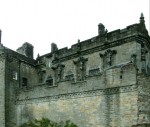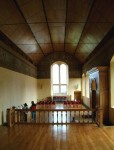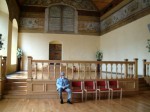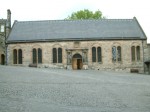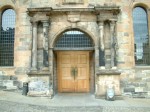The Chapel Royal – Stirling Castle
- St Clair Window – Chapel Royal – Stirling Castle
- Stirling Castle from the West
- The interior of the Chapel Royal looking south
- The interior of the Chapel Royal
- Chapel Royal – Stirling Castle
- Entrance to the Chapel Royal
Stirling Castle was one of the most important defensive structure, defending the main, central, route to the north of the kingdom Scotland. As such it has played many parts in Scottish history the best known being that it was the cause for the Battle of Bannockburn. The castle was held for the English by Philip de Mowbray. The brother of Robert Bruce (1306 – 1329, born 1274) , Edward Bruce, negotiated a truce with Mowbray in 1313 that the castle would be surrendered to the Scots if it had not been relieved by midsummer of the following year. This meant that Robert I was committed to the set piece battle he had always sought to avoid. However, with a year’s warning both he and his adversary, Edward II (1307 – 1327, born 1284), had plenty of time to make preparations. The battle was fought on the 23rd and 24th June 1314 and the Scottish victory ensured the Independence of Scotland for a further 400 years. Bannockburn and the possible involvement of the Knights Templar, the creation of Freemasonry, the St Clair family, Rosslyn Chapel, and other suggested ‘connections will be discussed elsewhere on this website.
As Stirling Castle was an important defensive position and was used by the Royal family it is somewhat surprising that a personal Chapel, specifically a Collegiate Church, had not been formally established before 1499. The reasons for this are numerous. It is likely that there was a personal place of worship set aside within the castle for use by the Scottish Royal family but was never ‘formalised’ as such, possibly due to the rarity of their visits and therefore the infrequency of its use. The castle, being a strategic fortification, may also have been considered more important in that context and that a formal place of worship was not required in what was a military base.
The creation of a Collegiate Church at Stirling Castle was actively being discussed at the very end of the 15th century when a gathering of clergymen under the leadership of one David Trail was convened. Trail was described as the ‘Provost of the new college in the castle of Stirling’. He held that position, apparently a temporary one until the college was established, from July 1499 to July 1501. James IV (1488 – 1513, born 1473) petitioned, Rodrigo Borgia, Pope Alexander VI (1492 – 1503, born 1431) for the erection of the Chapel Royal of St Mary and St Michael, Stirling. The petition was successful and the Collegiate Church was created for a Dean, sub-dean, Sacrist, sixteen Canons and six choristers.
It was arranged, in September 1501, that the Provostry of St Mary on the Rock, St Andrews, was to be combined with that of the Chapel Royal, Stirling, creating a Provost with superiority over both Collegiate Churches. The subsequent, and rather tortuous history of the Collegiate Church is told under the various pages which can be accessed by clicking on the above images or by using the side bar.
During the Reformation the Collegiate Church became ruinous and unfit to be used by the Royal family of Scotland. The original Collegiate Church was demolished and that which presently exists, although recently much restored, was erected in 1594.
That building was built by William Schaw (c.1550 – 1602)and both he and the building are of great interest to Masonic historians.
To be continued…

